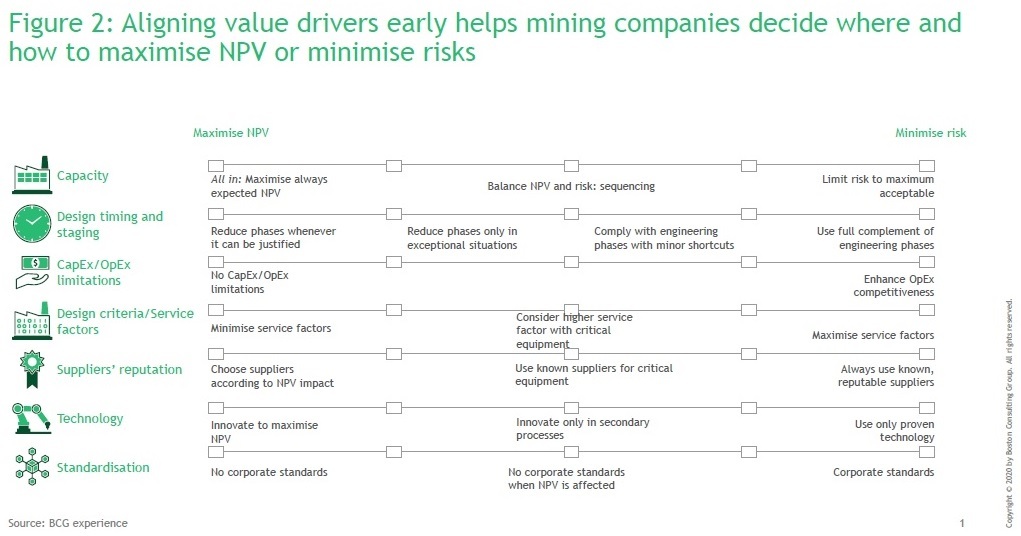Companies can no longer easily and frequently modify their original project designs to reflect changes in (for example) plant layouts. Instead, they're locked into building precisely what's in the initial project plan. And if requirements change, owners may end up with assets that miss the mark.
For companies managing multi-billion-dollar portfolios of capital projects, all at different stages (target and scoping, pre-feasibility, feasibility, execution), the possibility that projects will fail in these ways becomes even greater.
To manage capital projects more effectively in today's permitting environment, mining companies must decide on and articulate the right design for each project as early as possible. That requires rigorous analysis as well as close, ongoing collaboration among projects' many stakeholders.
Value engineering methodology can help.
Boston Consulting Group's approach has three main steps:
1. Align business needs including clarifying strategic objectives that projects must meet, particularly the value they're intended to deliver.
2. Develop initiatives for generating the required value.
3. Monitor implementation to capture value and best practices.
Owners that adopt value engineering can gain impressive results (see figure 1, below).

For instance, some have lowered their capital expenditures by as much as 30%. Others have been able to increase net present value (NPV) by 100%-200%, enhancing confidence in decisions to move ahead with projects that leaders might otherwise have deemed too risky. With these benefits in mind, let's take a closer look at how to apply value engineering.
Align business needs
Review the projects in your capex portfolio, asking which are most relevant for generating forms of value that matter most to your company as well as where and how to maximise NPV and minimise project risks (figure 2, below).

Consider a mining company that has a multi-billion-dollar portfolio of capital projects, each at different permitting stages. The projects are essential for the company to maintain production. But leaders want to optimise project designs with an eye toward boosting specific project value—including lowering capital and operating costs, accelerating speed to operation and boosting asset capacity. They estimate the size of opportunity—based on criteria such as capex required, technological complexity and degree of relevant pre-experience of their team. This exercise supports early thinking about which capital projects constitute the most promising candidates for value engineering.
Develop initiatives for delivering the required value
Focus on the most promising project opportunities in the portfolio by considering initiatives that could help optimise project designs. For instance, can a site's layout be reconfigured to take advantage of interfaces between contractors or equipment? Can equipment be chosen that would have the lowest total cost of ownership against project requirements? Can costs be lowered and project schedules tightened by creating a standardised or modular design?
To answer such questions and agree on the main opportunities, conduct workshops with representatives from all stakeholder groups (engineering, operations and maintenance, legal, finance, permitting). The most common topics for discussion during these workshops are technology, process simplification, standards, constructability, capacity and minimal technical solutions. Gauge the potential impact of each initiative, focusing on value drivers most important to your company. Approximate the magnitude of that impact (low, medium, high), and then estimate how easily it could be achieved. This exercise helps teams identify the best initiatives.
Held early on, these workshops can boost confidence in assessments of projects' potential value and in the designs required to deliver that value. Equally important, the workshops lay the foundation for a strong sense of ownership of projects that the company decides to implement, as well as foster alignment of stakeholders behind project plans.
For each initiative prioritised, specify an owner, highlighting budget and timeline. Assess the main risks. For example, if an initiative involves reconfiguring haulage processes and equipment at an existing site, how would these changes affect the site's surrounding community, and how might residents respond? What risks could the permitting-application process encounter? How can those be managed?
After the workshops, deepen the analysis with the different actors to sharpen your project plans. Agile groups are needed to align stakeholders behind the plans, confirm the details and recommend specific changes to include in the design. The most effective agile team members think as owners do, are ambitious, look for simple solutions, design according to constructability, test designs with final users and consider risks.
Monitor implementation to capture value and best practices
For each initiative prioritised, build a project charter showing the owners, the expected value to be generated and the milestones that must be reached to deliver the value.
Create a schedule for regular (we suggest weekly) meetings to review progress. Additionally, design dashboards to be used to track progress against the plan. Include a feature that helps project teams easily see which aspects are on track, which are at risk (for example, of missing a key milestone or going over budget) and which need immediate corrective intervention. Capturing best practices starts on the job, with coaching, but should also be integrated in the company's training programmes.
Large capital projects will always come with some degree of risk for mining companies.
That's not surprising, given these projects' complexity, magnitude and diverse array of stakeholders. But in today's age of stricter permitting processes, the risk of getting locked into project designs that ultimately miss the mark gets even worse.
To boost the odds that projects deliver the hoped-for value, mining companies must bring stakeholder groups together—from the outset—to agree on what each project's objectives are and how the project should be engineered to ensure that those objectives are met. This approach not only helps companies prioritise the right projects; it also lowers the risk that costly and time-consuming changes will have to be made later.
Yes, value engineering requires ways of managing large projects that in several respects may seem alien or overly complex to some mining companies. But it's already paying big dividends for companies that have taken the time to master it.
*Agustin Costa (costa.agustin@bcg.com) is a managing director and partner at BCG in Santiago; Pierre-Yves Galopin (galopin.pierreyves@bcg.com) is an associate director at BCG in Santiago; Patricia Downing (patricia.downing@MMG.com) is the general manager of development at MMG; Warrick Lanagan (lanagan.warrick@bcg.com) is a managing director and partner at BCG in Perth.


























